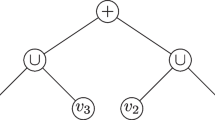Abstract
We show that the graph isomorphism problem, is low for PP and for C=P, i.e., it does not provide a PP or C=P computation with any additional power when used as an oracle. Furthermore, we show that graph isomorphism belongs to the class LWPP (see Fenner, Fortnow, Kurtz [12]). A similar result holds for the (apparently more difficult) problem Group Factorization. The problem of determining whether a given graph has a nontrivial automorphism, Graph Automorphism, is shown to be in SPP, and is therefore low for PP, C=P, and Mod k P,k≥2.
Similar content being viewed by others
References
L. Babai, Moderately exponential bound for graph isomorphism, inProc. Fundamentals of Computation Theory Conference, Lecture Notes in Computer Science #117 (1981), 34–50.
L. Babai, G. Cooperman, L. Finkelstein, E. Luks, Á. Seress, Fast Monte Carlo algorithms for permutation groups, inProc. 23rd ACM Symposium on Theory of Computing, 1991, 90–100.
L. Babai, E. Luks, Á. Seress, Fast management of permutation groups, inProc. 28th IEEE Symposium on Foundations of Computer Science, 1988, 272–282.
L. Babai, S. Moran, Arthur-Merlin games: A randomized proof system, and a hierarchy of complexity classes,Journal of Computer and System Sciences 36 (1988), 254–276.
J.L. Balcázar, J. Díaz, J. Gabarró,Structural Complexity I, Springer, 1987.
R. Beigel andJ. Gill. Counting classes: thresholds, parity, mods, and fewness,Theoretical Computer Science 103, (1992), 3–23.
R. Beigel, L. Hemachandra., G. Wechsung, Probabilistic polynomial time is closed under parity reductions,Information Processing Letters 37 (1991), 91–94.
R. Boppana, J. Hastad, andS. Zachos, Does co-NP have short interactive proofs?Information Processing Letters 25 (1987), 127–132.
J. Cai, L.A. Hemachandra, On the power of parity, inProc. 6th Symposium on Theoretical Aspects of Computer Science, Lecture Notes in Computer Science # 349 (1989), 229–240.
S.A. Cook, The complexity of theorem-proving procedures, inProc. 3rd ACM Symposium on Theory of Computing, 1971, 151–158.
S. Even, A. Selman Y. Yacobi, The complexity of promise problems with applications to public-key cryptography,Information and Control 61 (1984), 114–133.
S. Fenner, L. Fortnow, S. Kurtz, Gap-definable counting classes, inProc. 6th Structure in Complexity Theory Conference, 1991, 30–42.
M. Furst, J. Hopcroft, E. Luks, Polynomial time algorithms for permutation groups, inProc. 21st IEEE Symposium on Foundations of Computer Science, 1980, 36–41.
M.R. Garey, D.S. Johnson,Computers and Intractability: A Guide to the Theory of NP-Completeness, Freeman, San Francisco, 1979.
J. Gill, Computational complexity of probabilistic Turing machines,SIAM Journal on Computing 6 (1977), 675–695.
O. Goldreich, S. Micali, and A. Wigderson, Proofs that yield nothing but their validity and a methodology of cryptographic protocol design, inProc. 27th Symposium on Foundations of Computer Science, 1986, 174–187.
S. Goldwasser, S. Micali, andC. Rackoff, The knowledge complexity of interactive proofs,SIAM Journal on Computing,18(1), (1989), 186–208.
S. Goldwasser, M. Sipser, Private coins versus public coins in interactive proof systems, inRandomness and Computation., S. Micali, editor, volume 5 ofAdvances in Computing Research, JAI Press, 1989, 73–90.
F. Green, On the Power of Deterministic Reductions to C=P, to appear inMathematical System Theory.
M. Hall,The Theory of Groups, Macmillan, New York, 1959.
U. Hertrampf, Relations among MOD-classes,Theoretical Computer Science 74 (1990), 325–328.
C. Hoffmann,Group-Theoretic Algorithms and Graph Isomorphism, Lecture Notes in Computer Science #136, Springer, 1982.
C. Hoffmann, Subcomplete generalizations of graph isomorphism,Journal of Computer and System Sciences 25 (1982), 332–359.
M. Jerrum, A compact representation for permutation groups,Journal of Algorithms 7 (1986), 60–78.
D.S. Johnson, The NP-completeness column: An ongoing guideJournal of Algorithms 6 (1985), 434–451.
D. Kratsch, L.A. Hemachandra, On the complexity of graph reconstruction, inProc. 8th Fundamentals of Computation Theory Conference, Lecture Notes in Computer Science #529 (1991), 318–328. To appear inMathematical Systems Theory.
J. Köbler, U. Schöning, J. Torán andS. Toda, Turing Machines with few accepting computations and low sets for PP,Journal of Computer and System Sciences 44 (1992), 272–286.
E. Luks, Isomorphism of Graphs of Bounded Valence can be tested in Polynomial Time,Journal of Computer and System Sciences 25 (1982), 42–65.
R. Mathon, A note on the graph isomorphism counting problem,Information Processing Letters 8 (1979), 131–132.
M. Ogiwara, L. Hemachandra, A complexity theory for closure properties, inProc. 6th Structure in Complexity Theory Conference, 1991, 16–29.
C. Papadimitriou, S. Zachos, Two remarks on the power of counting, in6th GI Conference on Theoretical Computer Science, Lecture Notes in Computer Science #145 (1983), 269–276.
U. Schöning,Complexity and Structure, Lecture Notes in Computer Science #211, Springer, 1986.
U. Schöning, Graph isomorphism is in the low hierarchy,Journal of Computer and System Sciences 37 (1988), 312–323.
J. Simon,On some central problems in computational complexity, Ph.D. Thesis, Cornell University, 1975.
C. Sims, Computation with permutation groups, inProc. 2nd ACM Symposium on Symbolic and Algebraic Manipulations, 1971, 23–28.
J. Tarui, Degree complexity of boolean functions and its applications to relativized separations, inProc. 6th Structure in Complexity Theory Conference, 1991, 382–390.
S. Toda, PP is as hard as the polynomial-time hierarchy,SIAM Journal on Computing 20(5) (1991), 865–877.
S. Toda, Private communication.
J. Torán, Complexity classes defined by counting quantifiers,Journal of the ACM 38 (1991), 753–774.
L.G. Valiant, The relative complexity of checking and evaluating,Information Processing Letters 5 (1976), 20–23.
L.G. Valiant, The complexity of computing the permanent,Theoretical Computer Science 8 (1979), 189–201.
L.G. Valiant, V.V. Vazirani, NP is as easy as detecting unique solutions,Theoretical Computer Science 47 (1986), 85–93.
K.W. Wagner, The complexity of combinatorial problems with succinct input representation, inActa Informatica 23 (1986), 325–356.
Author information
Authors and Affiliations
Rights and permissions
About this article
Cite this article
Köbler, J., Schöning, U. & Torán, J. Graph isomorphism is low for PP. Comput Complexity 2, 301–330 (1992). https://doi.org/10.1007/BF01200427
Received:
Issue Date:
DOI: https://doi.org/10.1007/BF01200427




